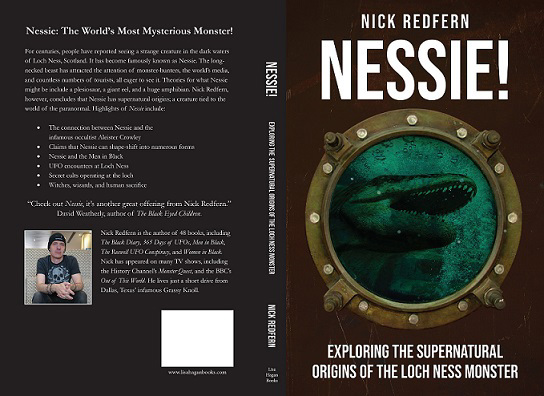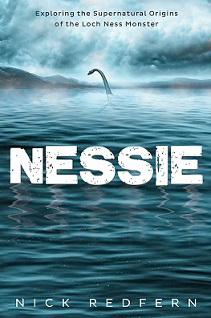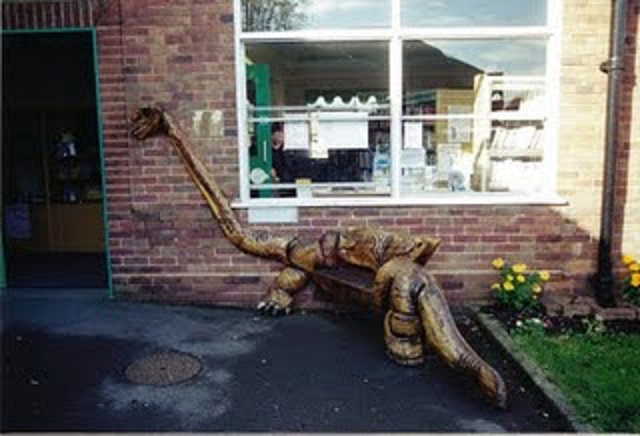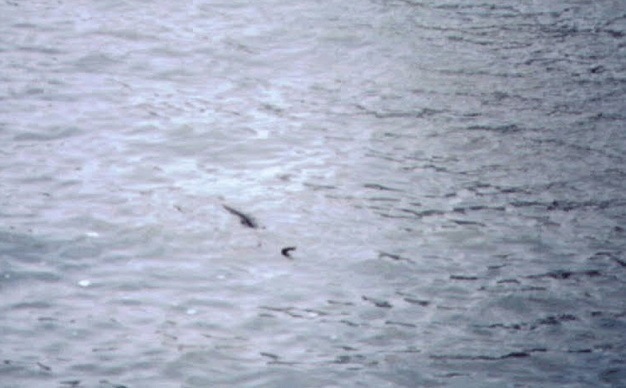The Loch Ness Monsters of the 1970s: When Things Were Wild!

Nineteen-seventy-four was a year in which Tim Dinsdale made a notable, but carefully and tactfully worded, statement to Nessie seeker Ted Holiday on the paranormal connections to the mystery of the Loch Ness beasts. As far as the monster-hunting community of the day was concerned, Dinsdale was firmly and forever in the flesh and blood category, when it came to the nature of the creatures of the loch. Many within that community are still of that opinion today; chiefly because they are unaware of what was going on behind the scenes. Firmly and forever however, are far too rigid and incorrect words to use. Privately, Disndale had a sneaking suspicion that something else was very possibly afoot, even if he preferred to not overly broadcast his views publicly. While Dinsdale’s stance of large-scale silence on the matter of the supernatural aspects of the Nessie controversy may be understandable to some, it also smacks of a man unsure of himself and lacking in strength of character to say, publicly, what he really thought. Or, at the very least, what he suspected.
In April 1974 – and in a private reply to a letter that Holiday had sent to him, describing the most recent weirdness at the loch, including an exorcism and a creepy Man in Black affair – Dinsdale had some notable things to say. He admitted to Holiday that he had crossed paths with what appeared to be a paranormal component to the mystery of the monsters of Loch Ness, but he remained baffled regarding how something of a supernatural nature could provoke such things as wakes in the water, photos, and sonar-recordings. It’s very instructive to note that Tim Dinsdale’s thoughts on the supernatural theory for the Nessies went right back to 1965; which was only a few, short years after his long-championed film-footage was secured.

In September of that year, Dinsdale traveled to the loch, for the ninth time, with the hope of securing high-resolution imagery of the creatures – specifically from the south shore, east of Foyers Bay. It wasn’t just Dinsdale’s ninth expedition. It very nearly proved to be his final visit to those notorious waters. Indeed, the trip was plagued by an extraordinary amount of escalating disasters. His small boat was capsized. He was quickly laid low by a viral infection. He suffered repeated problems with his electrical equipment (something that is often reported in both UFO- and Bigfoot-themed encounters, too). And he badly damaged one of his hands; almost losing the tip of one of fingers in the process.
Some might put this catalog of disasters down to just unfortunate circumstances and nothing else. Dinsdale, however, felt very strongly otherwise. He said, of this fraught and weird time, that having suffered such health-related calamities he knew it was time to leave behind him both Loch Ness and the distinct sense of unease he experienced whenever he visited the loch. “It was,” said Dinsdale, “as though some awful influence pervaded the atmosphere. Something evil.” Those are quite astonishing words for a man who, publicly, saw the Nessies as flesh and blood animals and nothing else. Half a decade later, Tim Dinsdale crossed paths with Winifred Cary. She was the psychic who Ted Holiday came to know well, and who had much to say about the Sundberg UFO sighting of 1971 and the Reverend Omand’s exorcism of 1973. The home she shared with her husband, Basil, overlooked Urquhart Bay and she claimed no less than sixteen sightings of the Nessies over a period of almost sixty years. Winifred Cary was also a highly skilled dowser who said she could use her powers to seek out a Nessie. Apparently, she did exactly that. And she did far more, too: she found evidence of no less than two creatures in the loch. Dinsdale, very impressed by Cary’s psychic skills, raced to the water’s edge, jumped in his boat, and headed out to the two spots where Cary identified monsters apparently lurking. Amazingly, Dinsdale’s sonar-equipment picked up something only 600 feet from Cary’s first site. More impressive, another sonar image was picked up exactly where Cary said a monster was present.

This demonstrates that not only did Dinsdale recognize the supernatural aspects of the Loch Ness Monsters themselves, he also recognized that they could be tracked down by supernatural means – in this case, by water-divining. Then, late one night in 1975, while negotiating the precarious hills that stand west of Urquhart Bay, and while making his way to his boat – the appropriately named Water Horse – Dinsdale experienced something strange. He was shocked and terrified by the sight of a weird blue light that, very curiously, appeared to come out of the very soil itself, and around 120 feet in front of him. Rather notably, the flash coincided with Dinsdale checking his watch. It was precisely midnight…the witching hour. That was not good. Not good in the slightest. Such was the intensity of the light, it lit up an entire nearby field, as well as the trees that led down to the water’s edge. Suddenly, there was a second flash, but this time it came from above the surface of the loch itself. Dinsdale took a deep breath, tried to calm himself, and took the Water Horse to the loch. It was all to no avail, however: the lights did not return and no answer was ever found for what caused them. Nevertheless, something continued to torment Dinsdale’s mind. You may already have guessed what that was. That’s right, the almost certainly relevant matter of the curious timing: midnight; just about the darkest and most sinister hour of all.
Loch Ness Monster authority Roland Watson notes that similar blue lights have been seen at the equally monster-infested Loch Morar, home to the legendary Morag. On top of that, Dinsdale was, on one occasion, chilled to the absolute bone by a banshee-like wailing that echoed around Loch Morar, at the height of a violent, 3:00 a.m. thunderstorm. Two years after quietly admitting to Ted Holiday that there appeared to be a supernatural aspect to the matter of the Loch Ness Monsters, Dinsdale yet again demonstrated his interest in matters that many assumed were far removed from the domain of the Loch Ness Monsters. In 1976, and in the pages of his Operations Newsletter, Dinsdale wrote that not only did he hope to continue to liaise with colleagues engaged in the search for the Nessies – and also those seeking the Morags of Loch Morar – he also wished to do likewise with people doing research in the fields of alien encounters, Sasquatch, and supernatural activity. Australian monster-hunter,
Tony Healy, met with Dinsdale, at Loch Ness, in 1979. Healy later stated that Holiday did indeed have a firm belief in at least some supernatural manifestations. Indeed, Dinsdale shared with Healy the details of some of his experiences. One story, in particular, stands out. Incredibly, Healy revealed that on one occasion, late at night, and while Dinsdale had the Water Horse tethered close to Ft. Augustus Abbey, he, Dinsdale, heard what sounded distinctly like someone being flogged and screaming for their life. For Dinsdale, it was possibly a glimpse into the past, the sounds of someone being violently tortured at the height of what became known as the Jacobite Rebellion of 1745. It was a tumultuous battle in which “Bonnie Prince Charlie” tried – but failed – to seize the British throne for the House of Stuart.

Nineteen-seventy-nine was also the year that Ted Holiday passed away, from a heart attack, at a prematurely young age: he was only in his late fifties. More than a few researchers who held similar views to those of Holiday believed that his early demise was a direct result of his attempts to confront and combat the supernatural activity that dominated Loch Ness. A tragic victim of malevolent monsters. Four years later, in 1983, the late Eric Beckjord – a researcher who believed that just about every weird critter under the sun had supernatural origins (and, just perhaps, they really do) – visited Dinsdale and learned something fascinating. Dinsdale told Beckjord how, one night, while moored near Aleister Crowley’s Boleskine House, he encountered all manner of supernatural entities trying to attack him and board his boat, including specters, demonic things, and ghoulish creatures. Dinsdale stressed they did him no physical harm, but as Beckjord noted, “they finally killed off the plesiosaur idea for him.”
The mid-1970s, when Tim Dinsdale found his mind in a supernatural whirl – are noted for something else with a supernatural Nessie-based tie-in. That was when the U.S. Government – and predominantly the CIA, Defense Intelligence Agency, and the U.S. Army – began to secretly fund extensive research into the phenomenon of what has become known as remote-viewing. The goal was to have skilled psychics utilize supernatural phenomena, extra-sensory perception, and out-of-body episodes to spy on – amongst others – the Russians, the Chinese, and various troublesome nations in the Middle East. The remote-viewers were, then, Uncle Sam’s very own paranormal 007’s. In many respects they were the 20th century equivalents of Dr. John Dee, mixing espionage and the occult in strange and swirling fashion. One of those who sought to understand the full scope of the remote-viewing program was the well-known conspiracy researcher/author Jim Marrs. During the course of his investigations, Marrs learned something incredible. Namely, that the RV team, at one point, had focused their psychic skills on the Loch Ness Monster. In doing so they stumbled onto something amazing, and which added much weight to the argument that the Nessies are supernatural in nature.

Marrs said that over the course of a number of attempts to remote-view the Nessies, the team found evidence of what appeared to be physical, living creatures – ones that left wakes and which could be photographed and tracked. They even prepared drawings which suggested the Nessies might be plesiosaurs. But, there was something else, too: the ability of the creatures to vanish – as in dematerialize. The remote-viewers were in a collective quandary: their work certainly supported the theory that some seriously strange creatures dwelled deep in Loch Ness, but they were creatures that seemed to have supernatural and abnormal qualities about them – which is precisely what both Ted Holiday and Tim Dinsdale finally came around to believing. Jim Marrs noted: “Considering that reports of human ghosts date back throughout man’s history, the Psi Spies seriously considered the possibility that the Loch Ness monster is nothing less than a dinosaur’s ghost.”
It’s interesting to note that the phenomenal and worldwide coverage that the Loch Ness Monsters achieved in the mid-1970s, and coupled with the deep attention given to the supernatural aspects of the controversy by the likes of Ted Holiday, had an impact on the production team behind the BBC’s long-running, hugely popular science-fiction series, Dr. Who. From August 30 to September 20, 1975, the BBC ran “Terror of the Zygons.” It was a four-part story, broadcast on Saturday evenings, and which put an interesting spin on the story of the Loch Ness Monster. In much the same way that the monster of the 1970 movie, The Private Life of Sherlock Holmes, was actually an advanced piece of machinery – namely, a carefully camouflaged submarine – so was the Nessie that tangled with the world’s most famous, fictional time-traveler, Dr. Who. “Terror of the Zygons” tells the story of an alien race, the Zygons of the title, whose home world was decimated and destroyed by solar flares centuries ago. As a result, they decide to create a new home for themselves. No prizes for guessing the planned location of that new home: the Earth. The one, solitary band of Zygons that successfully makes the journey to Earth has the distinct misfortune to crash in none other than Loch Ness. And they remain there for hundreds of years, patiently planning for the day when they can finally claim the Earth as their own.
To help them in their quest to seek control of the planet, the Zygons employ the use of a terrifying, huge monster known as the Skarasen. It’s an ancient beast of the deep waters that the Zygons turn into a cyborg – a half-flesh, half-machine that does their every bidding and which lives in Loch Ness. It has, over time, of course, become known as the Loch Ness Monster. That bidding includes a wave of mysterious and violent attacks on oil-rigs in the North Sea. It’s up to Dr. Who and his comrades, Sarah Jane Smith, Harry Sullivan, and Brigadier Lethbridge-Stewart, to defeat the deadly Zygons – who are shape-shifting monsters that can take on the form of any human being they choose. Fortunately, Dr. Who finally saves the day, as he always does. But not before the Skarasen/Nessie wreaks havoc in and around London’s River Thames and the Zygons do their very best to take hold of the planet.
There can be little doubt that the writing team behind the story had some knowledge of the lore and legend of Nessie. After all, the creature is presented as not just an unknown animal. Far from it, in fact. In addition, the story does not shy away from the UFO-themed connections to Loch Ness. And, let’s not overlook something else of great importance: the masters and manipulators of the Loch Ness Monster, the Zygons, are diabolical shape-shifters. Just the like the murderous kelpies and water-horses of centuries long past that haunted Loch Ness and terrified the local folk. Although strictly fiction, “Terror of the Zygons” provided an intriguing and thought-provoking scenario to explain the mystery of the Loch Ness Monster. That’s a pretty good case of excitement and fun for a Nessie-seeker!




